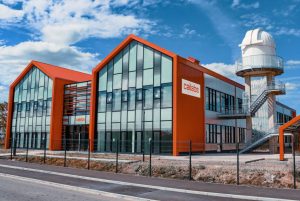What is the environmental impact of providing high-throughput connectivity for your campus?
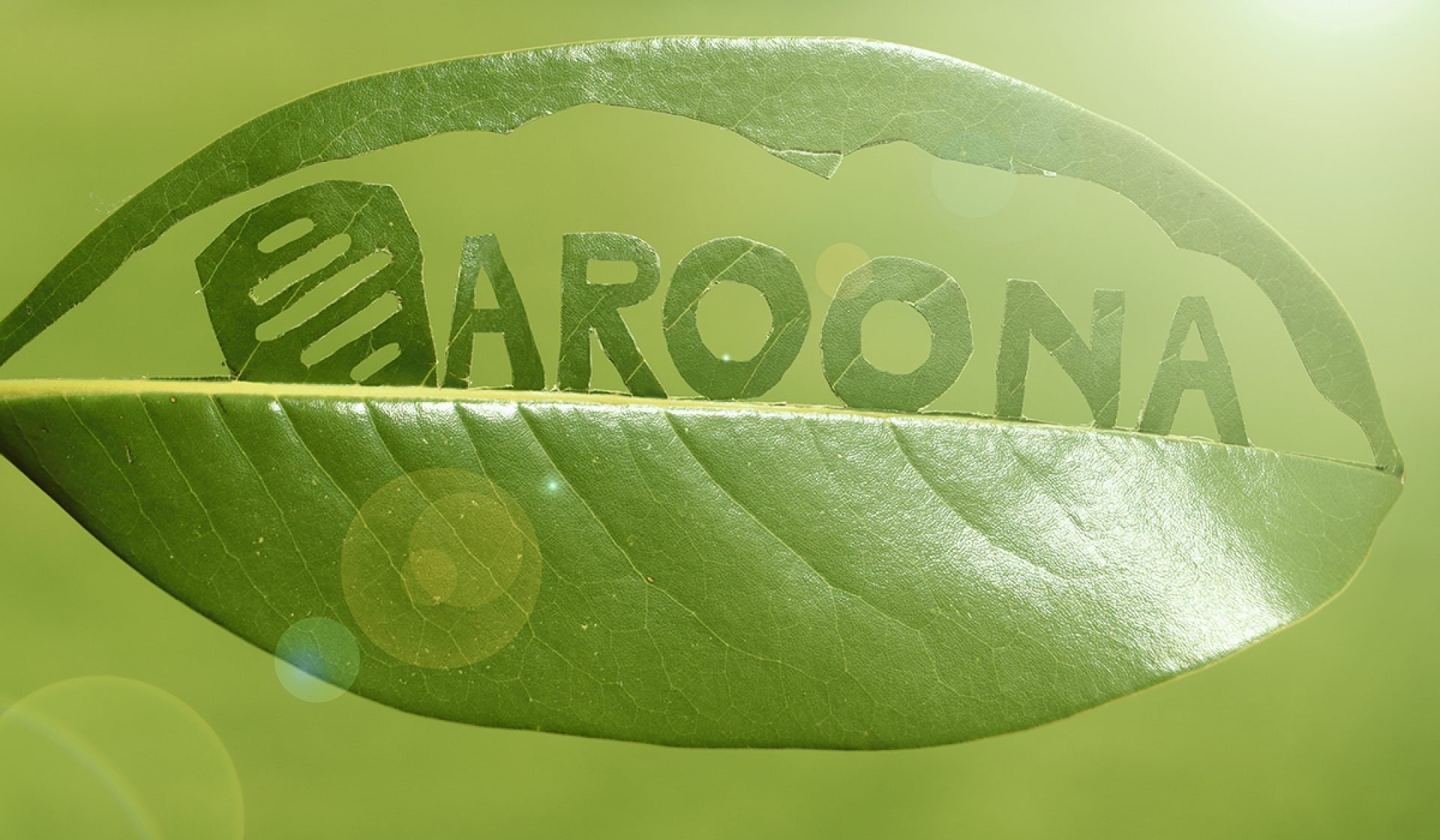
We face two major challenges in the 21st century: digital transformation and ecological transition. Ecological transition is an essential objective for humanity. Digital technology is one of the greatest transformative forces of our time.
Cailabs is continuously working to use its innovative optical technology to develop breakthrough products while minimizing its environmental impact. Our products are mostly passive, meaning they do not consume energy, and the AROONA solution in particular is aimed at campus IT networks.
This article presents an assessment of the carbon footprint of producing this product line through a comparative study with conventional cabling solutions.
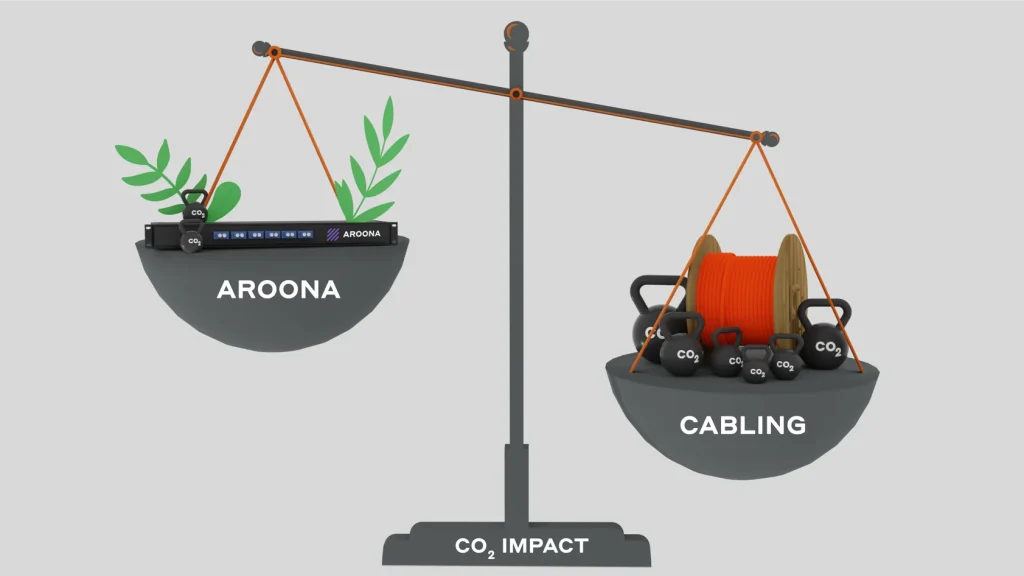
The challenge of the environmental impact of digital technology
The Information and Communication Technologies (ICT) sector is both a direct and indirect consumer of energy and an emitter of Greenhouse Gases (GHG). However, many studies show that digital technology can provide important leverage for progress in terms of reducing emissions and controlling energy consumption in related areas using ICT(1).
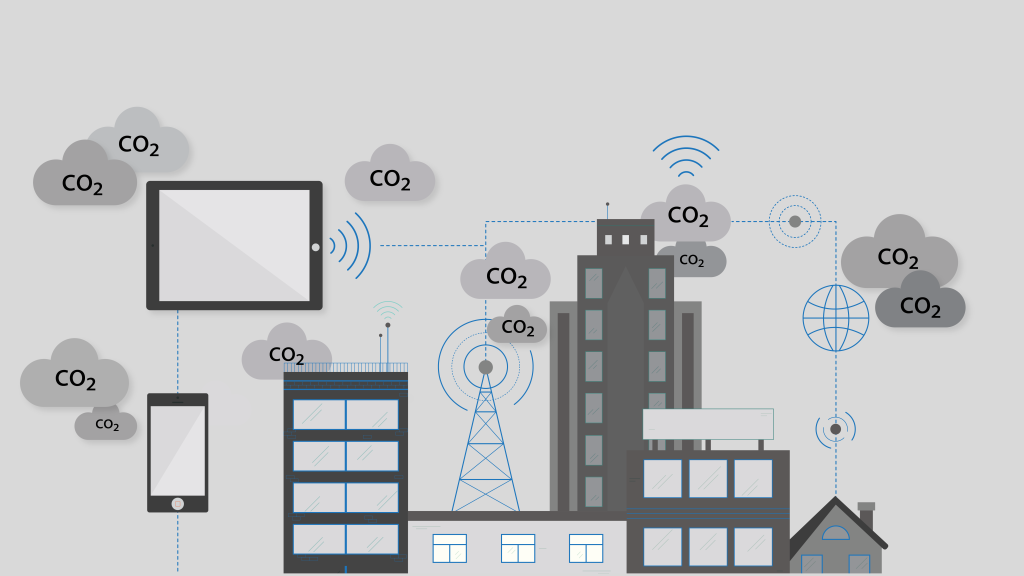
Like many other sectors that play a significant part in global GHG emissions, the ICT sector has an important role to play. It needs to develop environmentally friendly products and services to ensure that society reduces its carbon footprint(2). On a more general level, the United Nations has issued sustainable development goals to address the many challenges facing society(3).
For ICT equipment manufacturers and suppliers, the challenge is to reduce GHG emissions during the design, production and deployment phases of new products and services. For user organizations, the challenge is to reduce the carbon footprint of existing and future information systems.
“An AROONA-STAR-2 equipment, capable of upgrading a multimode duplex link up to 800m, generates less CO2 during production than one meter of optical cable!”
Cabling infrastructure: Why Rip & Replace when you can Upgrade & Reuse it?
It is therefore essential for all ICT stakeholders to have access to analysis methods and data repositories that provide a detailed understanding of possible reduction actions in their sectors. More and more equipment manufacturers are conducting Life Cycle Assessments (LCA) of their products as part of environmental statements(4,5). For its part, Cailabs has launched an assessment of the carbon footprint of producing its AROONA product line for local network cabling infrastructures.
Huge amounts of data are exchanged within corporate campuses every day. As a general policy, all campuses are “going digital”. Some vertical markets are making the switch faster than others, but all campuses will inevitably be required to upgrade their infrastructure to support current and future digital needs. Whether for schools, hospitals, industries or military bases, connectivity is an absolute necessity for all campuses.
AROONA is an innovative, cost-effective and easy-to-install solution that enhances existing optical networks, resulting in a considerable increase in bandwidth. It uses a simple passive device to upgrade legacy networks to meet growing throughput demands
The AROONA solution extends the service life of existing infrastructure(6), and provides an alternative to the deployment of next generation fiber optic cable to support increasing demand for bandwidth. This product line fits perfectly with the United Nations’ sustainable development goals(3) (SDG9: Industry, Innovation and Infrastructure and SDG12: Responsible Consumption and Production).
| AROONA vs cabling: carbon footprint analysis framework Before presenting the results of the study, let’s define the framework of the comparative analysis of the AROONA solution and conventional cabling. No new cable is required to install the AROONA passive solution. It may even help to avoid heavy cable replacement work. It is easy to imagine that digging a trench to pass a cable would generate a significant amount of CO2. So why rip and replace a cable when you can maximize its full potential using a clean, environmentally friendly technology? AROONA enables the more efficient use of resources by renewing legacy equipment. In practical terms, deploying new fiber optic cable requires: Fiber optic cable – Optical fiber connectors – An optical fusion splicing kit – Fiber optic enclosures and patch panels – Cable pulling or blowing equipment – Heavy equipment such as micro trenchers, compressors, etc. for deployments where existing ducts are full or damaged Upgrading an existing multimode fiber optic cable requires: – One AROONA device (or two for links greater than 800 m), consisting of one or more modal adapter modules + one rack for 4/8/12/24 fiber strands versions – An optical fusion splicing kit The carbon footprint analysis in the rest of the study will be done only between the optical cable and the AROONA modal adapter modules. |

In the life cycle analysis of passive structured cabling installations, manufacturing often accounts for most of the GHG emissions (>90% on average)(4). This includes the carbon footprint of raw materials and their transportation, and the carbon footprint of the production methods of the devices. For the AROONA solution, the production analysis is based on the LCA of optical equipment(5), the carbon footprint of the different raw materials(7) and their import(8).
It should be noted that the “installation” phase is often excluded from the scope of fiber optic cable life cycle analysis because of the variety of possible installation techniques, each with a different impact (pulling, blowing, porting, micro trenching for new ducts, etc.)(5). However, we don’t need to quantify the cable installation phase to see that it has a significant CO2 impact, likely much greater than installing a simple AROONA box in an existing network cabinet. So, the carbon footprint comparative analysis will be performed between the fiber optic cable and the modal adapter modules of the AROONA solution only, placing it at a disadvantage.
“The use of the AROONA solution on a university campus has saved more than 15 tons of CO2 in the production of equipment, equivalent to 15 return trips from Paris to New York.”
Comparative analysis
Let’s consider the Product Environmental Profile (PEP) of a typical fiber optic LAN cable (12 fibers, no connectors)(5). Its life cycle assessment indicates a carbon footprint of around 0.735 kg CO2-eq per meter of cable (note that the LCA provided by the equipment manufacturer does not vary much according to the number of strands in the cable: it is similar for a 6-fiber cable and 20% higher for a 24-fiber cable).
When deploying optical links in a campus network, this type of 12-fiber cable is relatively standard, so we will use it as our benchmark in the comparative analysis with AROONA. Typical intra-campus links range from a few hundred meters up to a maximum of two kilometers. This means that the fiber optic cable has a carbon footprint of between 70 kg CO2-eq and 1500 kg CO2-eq per link.
For the AROONA solution, the carbon footprint of manufacturing the mode matching modules is typically 0.6 kg CO2-eq for a 2-fiber device and about 11 kg CO2-eq for a 12-fiber device. The quantitative analysis for AROONA is based on the GHG balances of the various raw materials used (silica, ABS plastic, aluminum, fiber optic cable, cardboard, polystyrene, etc.), on the transport data for shipping these raw materials, and on the GHG footprint of producing the AROONA devices (5,7,8).
The amount of CO2 emissions generated by producing the product line is shown in the table below:
| Product (mode matching device + packaging) | Carbon footprint |
| AROONA-STAR 1 fiber | 0.4 kg CO2-eq |
| AROONA-STAR 2 fibers | 0.6 kg CO2-eq |
| AROONA-STAR 4 fibers | 5.3 kg CO2-eq |
| AROONA-STAR 8 fibers | 8.3 kg CO2-eq |
| AROONA-STAR 12 fibers | 11.3 kg CO2-eq |
| AROONA-STAR 24 fibers | 20.4 kg CO2-eq |
Based on the above figures, the following chart shows the carbon footprint of manufacturing the fiber optic cable and the AROONA solution as a function of link length. It is easy to see that AROONA devices provide significant CO2 savings compared to producing new cable.
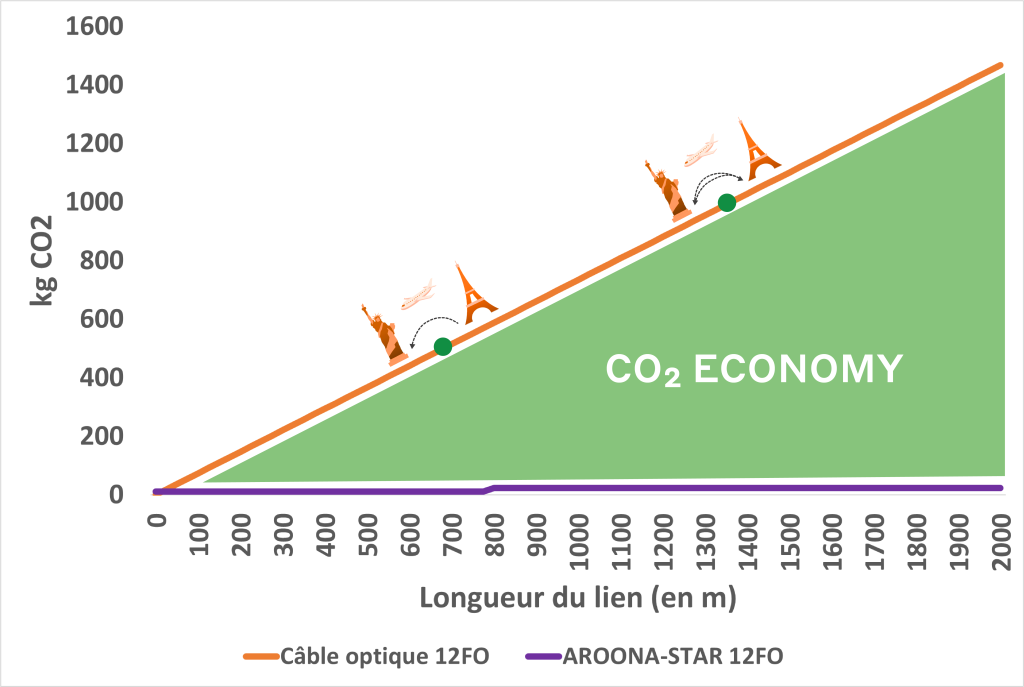
“Cailabs’ AROONA solution addresses the current connectivity challenges of campuses in a practical, cost-effective and environmentally friendly way.”
Case study: tons of CO2 saved per project!
To better illustrate the CO2 savings the AROONA solution can generate for a campus-wide project while matching the performances of new fiber optic cabling, let’s look at two specific case studies for our comparative analysis: a military campus and a university campus.
Military campus
A French military base upgraded part of its OM1 multimode cabling infrastructure (62.5/125 µm) with AROONA . The project included 18 buildings connected to the core network, with a minimum requirement of 2 duplex links per building. The links were between 200 m and 1800 m, with a total of about 17 km of fiber optic cable to be deployed in conventional point-to-point cabling on this star topology. To produce these lengths of cable would have generated 12.5 tons of CO2-eq during production.
For this project, around fifteen AROONA devices (from 2 to 12 fibers) were installed to maximize the performance of the existing fiber optic cables in the base, with a total of 130 kg CO2-eq generated for their production. For this classic example of upgrading a campus network cabling infrastructure, the AROONA solution reduced the carbon footprint by a factor of 100, with a similar value proposition, with a minimum saving of over 12 tons of CO2.

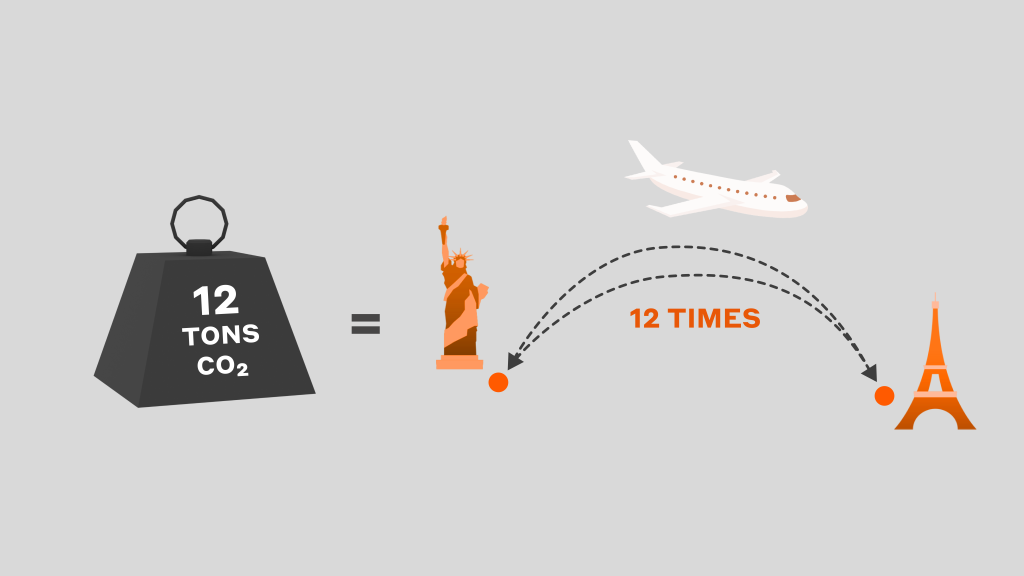
It should be noted that this analysis does not take into account the carbon footprint of the connectors and patch panels required, or the impact of cable deployment, which in this case would have required civil works to dig the micro-trenches required to install the new ducts. To understand the quantities involved in this project, the CO2 savings achieved by producing AROONA devices compared to fiber optic cable correspond to 12 round trips between Paris and New York(9) (or 75,000 km in an average car(7)).
University campus
The campus of a US university (Georgia Tech) has an OM1 multimode fiber (62.5/125 µm) cabling infrastructure connecting the core network to the various fraternity houses (approx. 30 located at a distance of between 150 and 1100 m). The wiring studies identified technical constraints with a significant financial impact on the project. Approximately 21 km of cable would have been required to lay new cables, which would have generated more than 15 tons of CO2-eq to produce (not including the impact of connectors / patch panels / deployment).
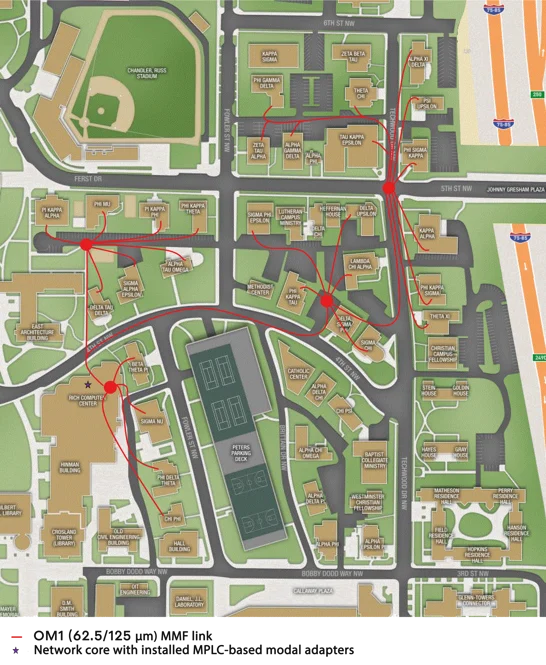
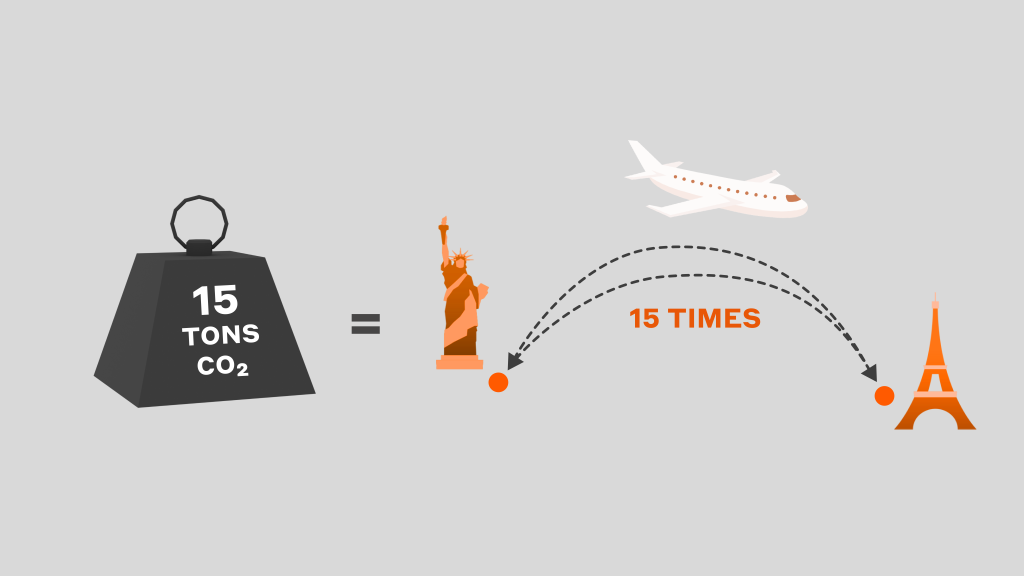
The AROONA devices meant that the existing links could be reused to meet the bandwidth needs of this part of the campus, with a total of 70 kg CO2-eq generated for their production. This meant a minimum saving of 15 tons of CO2, equivalent to 15 return trips from Paris to New York(9)(or 95,000 km in an average car(7)).
In conclusion:
All businesses, regardless of size, are concerned about the environmental impact of their operations, from SMEs to large accounts, from local authorities to government institutions. The CIOs of these organizations endeavor to be particularly “active” in this area and make smart decisions at all levels. New solutions must be carefully designed, produced and deployed, taking into account the impact of the ICT infrastructure on the overall project’s carbon footprint.
In this respect, the AROONA product line extends the service life of fiber optic cables and upgrades campus networks by recycling existing cabling infrastructure, making it a reliable, sustainable and resilient solution. In short, Cailabs’ AROONA solution addresses the current connectivity challenges of campuses in a practical, cost-effective and environmentally friendly way.
Sources :
(1) Technologies numériques, information et communication (TNIC). Guide sectoriel 2012 – Read the guide (in French)
(2) SMART 2020 — Enabling the low carbon economy in the information age – Read the report
(3) Sustainable Development Goals of United Nations : See the website
(4) Discover the environmental declaration PEP ecopassport® program (PSR-0001 products: Wires, cables and accessories).
(5) LCA Legrand 12-strand fiber optic cable: Read the Product Environmental Profile
(6) Environmental impacts of digital technology in France – Study & Recommendations: – Read the study (in French)
(7) Carbon footprint data for various materials: See the accounting
(8) Carbon footprint data for raw material imports: DHL carbon calculator
(9) Carbon footprint data for air transportation: Air France carbon calculator

By Kévin Lenglé
Kevin Lengle, who’s worked as a researcher at the CNRS (French National Research Center) and a telecom equipment manufacturer, holds a Master’s degree in Engineering from the National School of Applied Sciences and Technology and a Ph.D. in Physics. He’s been working at Cailabs as a Product Line Manager since 2015, bringing his expertise in optics and telecommunications to the development and commercialization of innovative optical solutions to fully harness the potential of multimode optical fibers.
